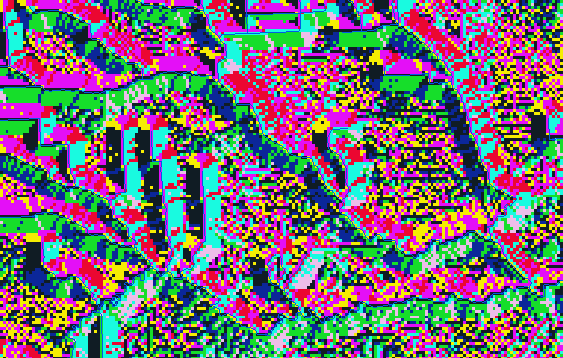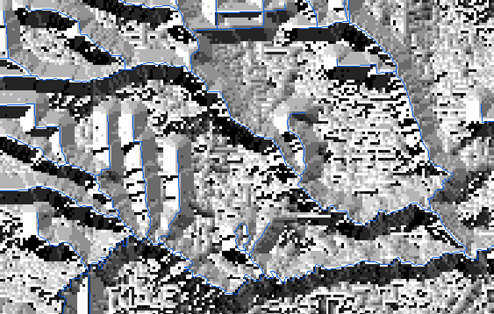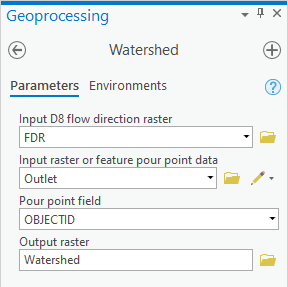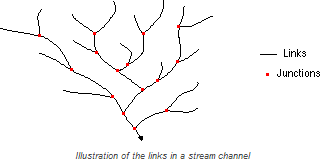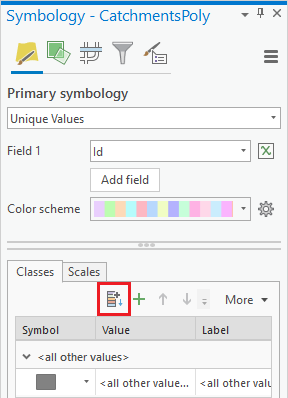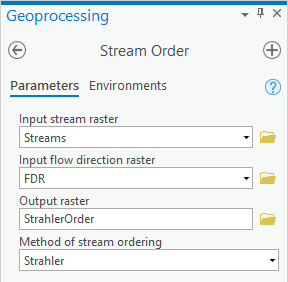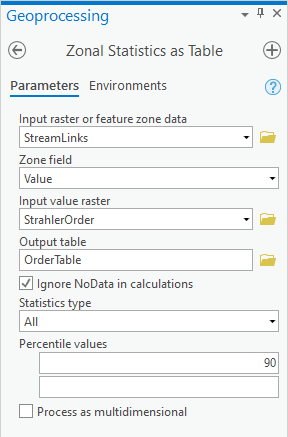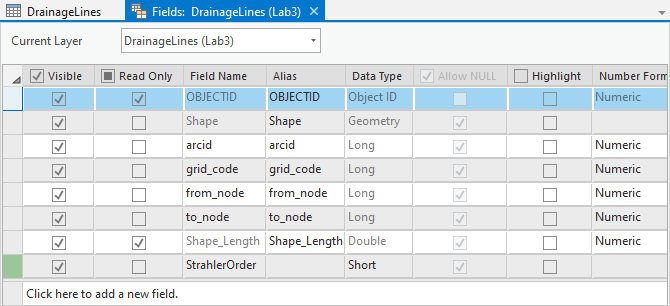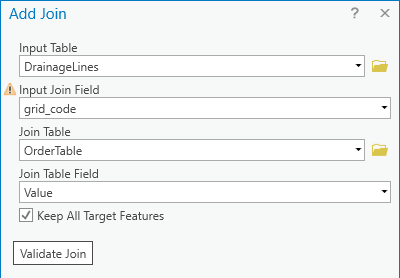...
- By double-clicking the 'Raster' layer names and 'Tools' operations and typing the numbers, enter the following equation: "DEMft" - 30 * "FlowlineReclass" - 0.02 * (1500 - "FlowlineDistance") * ("FlowlineDistance" < 1500).
- For ‘Output raster’, rename the raster from “demft_raster” to “DEMRecon”.
- Ensure your Geoprocessing pane appears as shown below and click Run.
Notice that the DEMRecon layer looks very similar to the original DEMft. To better understand the difference between the two, you will actually calculate the difference between their corresponding values.
...
- At the top left of the Geoprocessing pane, click the Back button.
- In the search box, type "flow".
- Click the Flow Direction tool.
- For ‘Input surface raster’, select the FIL layer.
- For ‘Output flow direction raster’, rename the raster from “FlowDir_FiIL1” to “FDR”.
- Ensure your Geoprocessing pane appears as shown below and click Run.
...
The result may appear a bit strange at first, due to the color scheme assigned to each cardinal direction.
- Symbolize the FDR layer using Unique Values with a smooth black and white gradient for the Color Scheme.
You will notice the layer now looks more similar to a hillshade or 3D terrain visualization.
Calculating flow accumulation
Finally, you will calculate flow accumulation in each cell from the cells upstream, as illustrated below. Flow accumulation is dependent on the flow direction you calculated previously.
- Return to the Geoprocessing pane.
- At the top left of the Geoprocessing pane, click the Back button.
- In the search box, type "flow".
- Click the Flow Accumulation tool.
- For ‘Input flow direction raster’, select the FDR layer.
- For ‘Output accumulation raster’, rename the raster from “FlowAcc_FDR1” to “FAC”.
- Ensure your Geoprocessing pane appears as shown below and click Run.
...
- In the Contents pane, uncheck Turn off the Flowlines_StatePlane layer to better see the FAC layer.
- Right-click the FAC layer and click the select Symbology.
- For ‘Symbology’, use drop-down menu to select‘Primary symbology’, select Classify.
- In the ‘Method’ drop-down menu to For ‘Method’, select Equal Interval.
- Use the ‘Classes’ drop-down menu to select8 classes.
- For ‘Classes’, select 8.
- In the 'Classes' tableFor ‘Class Breaks’, double-click the numbers in the Upper Value column and column and typethe following list: 100, 300, 1000, 3000, 10000, 30000, 100000. (Leave the final max value, 351408 as is.)
- Use the ‘Color Ramp’ drop-down menu to select the multipart color schemeFor ‘Color scheme’, scroll down to the very bottom and select the Yellow-Green-Blue (Continuous) color scheme, as shown below.
Visually trace along the streams until you find the darkest path exiting the watershed. Notice that, according to the model you have just generated, the Buffalo-San Jacinto basin drains north into Lake Houston, instead of south southeast into Galveston Bay. Look for the exact point on the map where this divergence is created. It is circled in the image below. A problem is that the topography in that area is extremely flat and, rather than a single well-defined channel, there are wide bodies of water connecting the bayous to Galveston Bay. Calculating the flow accumulation more accurately would require further editing the base raster so that the wide flat bodies of water are not treated as narrow flowlines. This example also illustrates how you must always double-check the results of your models to ensure they make sense. For the purposes of learning the remaining geoprocessing tools in this lab, you will continue with the existing flow accumulation model, as if it was correct.
Zoom into the northern outlet point, as indicated on the image above, so that you can see the individual pixels.
- Zoom in to the southeastern outlet point, as indicated below, so that you can see the individual pixels.
Creating and editing feature classes
You will now create a new point feature class to store the outlet point you just identified.Click
- At the bottom of the Symbology pane, click the Catalog tab.
- Right-click the
...
- HydrologyLab.gdb geodatabase and select New > Feature Class
...
- .
- For
...
- ‘Name’, type “Outlet
...
Use the ‘Geometry Type’ drop-down menu to selectPoint.
For Coordinate System, selectCurrent Map.
ClickRun.
...
- ”.
- For ‘Feature Class Type’, select Point.
- At the bottom, click Next.
- Click Next again.
- For 'Current XY', ensure NAD 1983 StatePlane Texas S Central FIPS 4204 (US Feet) is selected.
- Click Finish.
- In the Catalog pane, drag the newly created Outlet feature class into the Lab3 map view.
- On the ribbon, click the Edit tab and click the Create button.
...
- On the Create Features pane, select the Outlet layer and click Point
...
- button.
- In the
...
- map view, click near the center of the outlet pixel to draw a point there.
- On the
...
- ribbon, click the Save button.
- When asked if you want to save
...
- all edits, click
...
- Yes.
Delineating watersheds
Now you will delineate the watershed that flows to the outlet point.
Click Tools from Analysis tab
- At the bottom of the Create Features pane, click the Geoprocessing tab.
- At the top of the Geoprocessing pane, click the Back button.
- In the
...
- search box, type "watershed".
- Click the Watershed (Spatial Analyst Tools) tool.
- For ‘Input D8 flow direction raster’, select the FDR
...
- raster.
- For ‘Input raster or feature pour point data’ select the Outlet layer
...
- .
- For ‘Output raster’, rename the raster from “Watersh_FDR1” to “Watershed”.
- Ensure your Geoprocessing pane appears as shown below and clickRun.
...
- In the Contents pane, right-click the Watershed layer and select Zoom To Layer.
You can toggle the Subbasin_StatePlane layer on and off. Notice that the watershed boundary you have created
Notice that this is very close, but does not exactly match the boundaries of the subbasin you were originally provided from NHDPlus.
- In the Contents pane, turn off all layers beneath the Watershed layer, so that only the cells within the newly defined subbasin are visible.
Delineating streams
Now that you have delineated the subbasin boundaries, you will generate flowlines. The number of flowlines that are generated will depend upon the flow accumulation threshold you select in separating a flowline cell from a non-flowline cell. For the purposes of this lab, you will select a threshold of 3000.Click Tools from Analysis tab
- At the top left of the Geoprocessing pane, click the Back button.
- In the
...
- search box, type "calculator".
- Click the Raster Calculator (Spatial Analyst Tools) tool.
- Using the same clicking technique as before, enter the following equation: ("FAC" > 3000) & ("Watershed" > 0).
- For ‘Output raster’, rename the raster from “fac_rasterca” to “Streams”.
- Ensure your Geoprocessing pane appears as shown below and click Run.
...
Again you should have a binary raster, where flowline cells are assigned a value of 1 and all other cells are assigned a value of 0.
Generating stream links
Now you will separate your entire raster of flowlines into individual flowline segments as illustrated below.
...
- At the top left of the Geoprocessing pane, click the Back button.
- In the
...
- search box, type "stream".
- Click the Stream Link tool.
- For ‘Input stream raster’, select the Streams
...
- raster.
- For ‘Input flow direction raster’, select the FDR
...
- raster.
- For ‘Output raster’, rename “StreamL_Stre1” to “StreamLinks”.
- Ensure your Geoprocessing pane appears as shown below and click Run.
...
- Symbolize the StreamLinks layer using unique values.
- In the Contents pane, collapse the StreamLinks symbology.
Delineating catchment basins
Now you will delineate the catchment basin associated with each stream link. These catchment basins are similar to the subwatersheds you downloaded from NHDPlus.
Click Tools from Analysis tab.
...
- Return to the Geoprocessing pane.
- At the top left of the Geoprocessing pane, click the Back button.
- In the search box, type "watershed".
- Click the Watershed (Spatial Analyst Tools) tool.
- For ‘Input D8 flow direction raster’, select the FDR
...
- raster.
- For ‘Input raster or feature pour point data’ select the StreamLinks layer.
- For ‘Output raster’, rename “Watersh_FDR2” to “
...
- CatchmentsRaster”.
- Ensure your Geoprocessing pane appears as shown below and click Run.
...
- Symbolize the
...
- CatchmentsRaster layer using unique values.
...
- In the Contents pane, collapse the
...
- CatchmentsRaster symbology.
Converting rasters to features
Now you will convert the Catchments CatchmentsRaster raster into a polygon feature class.
Click Tools from Analysis tab.
...
- Return to the Geoprocessing pane.
- At the top left of the Geoprocessing pane, click the Back button.
- In the search box, type "raster to polygon".
- Click the Raster to Polygon tool.
- For ‘Input raster’, select the
...
- CatchmentsRaster layer.
- For ‘Output polyline features’, rename “RatsterT_Catchme1” to “
...
- CatchmentsPoly”.
- Uncheck Simplify
...
- polygons.
- Ensure your Geoprocessing pane appears as shown below and click Run.
...
- Symbolize the CatchmentPoly layer using unique values with ID as the value field. Make sure to click the Add all values button.
...
- In the Contents pane, collapse the CatchmentPoly symbology.
Now you will also convert the raster StreamLinks into a polyline feature class. While you could use the Raster to Polyline tool, you will instead use a tool in the Hydrology toolset, designed specifically for converting raster stream links into polyline features. The difference between the two methods is illustrated below.
...
Click Tools from Analysis tab.
...
- Return to the Geoprocessing pane.
- At the top left of the Geoprocessing pane, click the Back button.
- In the
...
- search box, type "stream".
- Click the Stream to Feature tool.
- For ‘Input stream raster’, select the StreamLinks
...
- raster.
- For ‘Input flow direction raster’, select the FDR
...
- raster.
- For ‘Output polyline features’, rename the feature class from “StreamT_StreamL1” to “DrainageLines”.
- Uncheck Simplify polylines.
- Ensure your Geoprocessing pane appears as shown below and click Run.
...
...
Calculating Strahler stream order
Now you will use the Strahler method to assign a flow hierarchy to the stream links as illustrated below.
...
- At the top left of the Geoprocessing pane, click the Back button.
- In the
...
- search box, type "stream".
- Click the Stream Order tool.
- For ‘Input stream raster’, select the Streams
...
- raster.
- For ‘Input flow direction raster’, select the FDR
...
- raster.
- For ‘Output raster’, rename the raster from “StreamO_Stre1” to “StrahlerOrder”.
- Ensure your Geoprocessing pane appears as shown below and click Run.
...
- In the Contents pane, turn off all layers except for the new StrahlerOrder layer, so that its symbology is more apparent.
Calculating zonal statistics
Now you would like to append this Strahler order to the attribute table of the DrainageLines vector layer, so that you may symbolize that layer using graduated symbols according to the Strahler order number. First, you will need to create a table indicating the Strahler order of each stream.Click Tools from Analysis tab
- At the top left of the Geoprocessing pane, click the Back button.
- In the
...
- search box, type "zonal statistics".
- Click the Zonal Statistics as Table (Spatial Analyst) tool.
- For ‘Input raster or feature zone data’, select the StreamLinks layer
...
- .
...
- For ‘Zone field’
...
- , select the Value field.
- For ‘Input value raster’, select the StrahlerOrder
...
- raster.
- For ‘Output table’, rename the table from “ZonalSt_StreamL1” to “OrderTable”.
- Ensure your Geoprocessing pane appears as shown below and click Run.
...
Adding a new field to an attribute table
Now you will create a new field in the DrainageLines attribute table to store the Strahler order number.
- Open the DrainageLines attribute table.
- At the top of the DrainageLines attribute table, click the Add Field button.
...
- In the bottom row of the table, for ‘ Field Name
...
- :’, type
...
- “StrahlerOrder”.
- Use the
...
- ‘Data Type:’ drop-down menu to select Short
...
- for short integer.
- Ensure your
...
- Fields table view appears as shown below
...
- .
- On the ribbon, under the Fields tab, click the Save button.
- Close the Fields table view.
Notice
Scroll all the way to the right and notice the new StrahlerOrder field has been added to the end of the DrainageLines attribute table. All of the values are currently null, but will later be populated with the Strahler Order integers from the OrderTable.
...
You are now ready to join the OrderTable to the DrainageLines layer based on their common identification fields.Click
- At the top right of the DrainageLines attribute table, click the Table Options button and select Joins and Relates > Add
...
- Join.
...
- For ‘Input Join Field’, select the grid_code field.
- For ‘Join Table’, select the OrderTable table.
- For ‘Output Join Field’, select the
...
- Value field.
- Ensure that your
...
- Add Join window appears as shown below and click
...
- OK.
...
Scroll across the table and notice that most of the statistics (Min, Max, Mean, Majority, Minority, Median) are the same and all contain the Strahler order integer, so it doesn’t matter which field you copy, though you will choose the MIN field for this lab.
- In the attribute table, right-click on the StrahlerOrder field header and select Calculate
...
- Field.
- Scroll down the list of
...
- ‘Fields’ and double-click the OrderTable.
...
- MIN field and click
...
- OK.
- Scroll down the newly populated StrahlerOrder field and notice the values of 1, 2, and 3 corresponding to Strahler order value.
Since you have copied the Strahler order into a field in the original DrainageLines attribute table, you You no longer need the tabular join.
- Again, click the Table Options button and select Joins and Relates
...
- > Remove All Joins.
- When asked if you are sure you want to remove all joins, click Yes.
- Symbolize the DrainageLines layer using graduated symbols based on the StrahlerOrder field.
- In the Contents pane, turn on only the Outlet, DrainageLines, and CatchmentPoly, layers and turn offall other layers.
...
FOR MAP LAYOUT TO BE TURNED IN
Create an 8.5 x 11 layout showing the vector catchment basins along with the stream links symbolized using graduated symbols according to their Strahler order and the outlet point that you used.
Deliverables
...
- Create an 8.5 x 11 layout showing the DEMRecon layer
...
- .
- Create an 8.5 x 11 layout showing the vector catchment basins along with the stream links symbolized using graduated symbols according to their Strahler order and the outlet point that you used.


